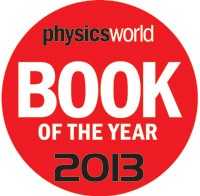By Margaret Harris

As the year draws to a close, it’s time for Physics World to dig into its cabinet full of popular-physics volumes, pore over the reviews and decide which of the 59 books we covered in 2013 deserves to be our pick for the year’s best.
As we did last year, we’ve begun by selecting a shortlist of the 10 books that most closely meet our award criteria, which are that the winning book must be novel, scientifically interesting and (of course) well written. This required us to make some tough choices: although many books fulfilled two of our requirements, fewer could claim high marks in all three areas.
The books on the 2013 shortlist are an eclectic group, reflecting the “big tent” nature of physics in recent times. They include popular-science works on biophysics, bombs and a seriously important boson, plus vivid biographies of two very different figures from the history of physics. And we are fairly certain that ours is the only “best books” list you’ll ever see that pits a scholarly argument about the nature of time up against a fan-friendly look at mathematics in the animated TV show The Simpsons.
We’ll be announcing the winner in a podcast on 17 December, when Physics World’s editor Matin Durrani, physicsworld.com reporter Tushna Commissariat and I will argue the merits of our favourite books from the list, while James Dacey makes sure the discussion doesn’t get too heated.
Until then, have a look at the shortlist below. Did we leave out your favourite? Or include a book that you didn’t particularly enjoy? If so, let us know in the comments or by e-mail at pwld@iop.org.
The shortlist for Physics World’s Book of the Year 2013 (with links to our reviews):
The Spark of Life: Electricity in the Human Body
Written by the physiologist Frances Ashcroft, this book covers a wide range of subjects, from the early “animal magnetism” experiments of the 18th-century physicist Luigi Galvani to Ashcroft’s own research on ion channels. It’s enlivened by vivid anecdotes from the careers of various people (including the author) who have worked at the boundary between physics, medicine and biology.
The Particle at the End of the Universe: How the Hunt for the Higgs Boson Leads us to the Edge of a New World
Cosmologist and physics blogger Sean Carroll gives readers an insider’s view of one of the decade’s hottest topics with this engaging account of the decades-long search for the Higgs boson.
Hans Christian Ørsted: Reading Nature’s Mind
Dan Charly Christensen’s biography is a vivid account of the life and times of one of the lesser-known pioneers of electromagnetism. It’s remarkable both for the depth of its research and for the superior way in which the author sets out the historical context of Ørsted’s discoveries.
Churchill’s Bomb: a Hidden History of Science, War and Politics
Graham Farmelo makes a repeat appearance on Physics World’s list of the year’s best physics books, having won top honours in 2009 for his biography of Paul Dirac. This time, Farmelo’s subject is the British atom-bomb programme and how blunders by wartime prime minister Winston Churchill allowed the UK’s early lead in atomic research to slip away.
Physics in Mind: a Quantum View of the Brain
Biophysicist Werner Loewenstein tackles a very big subject indeed with this book on human consciousness and the role that quantum-mechanical effects have in various neurological processes, including those associated with how we perceive the world around us.
J Robert Oppenheimer: A Life Inside the Centre
The philosopher Ray Monk took 11 years to research and write this monumental biography, and the result is a book that gets closer than any previous work to revealing what motivated one of the most complex figures in 20th century science.
The Simpsons and their Mathematical Secrets
Simon Singh’s examination of the mathematical titbits that appear in episodes of The Simpsons (and the gaggle of physics-friendly writers who put them there) is both a fun tribute to the enduringly popular TV show and a great excuse to explore some surprisingly complex mathematics.
Time Reborn: From the Crisis in Physics to the Future of the Universe
Lee Smolin’s far-reaching and ambitious book brings research on the outermost frontiers of physics to a popular audience and shows why an apparently esoteric topic – the fundamental nature of time – should matter to all of us.
The Theoretical Minimum: What You Need to Know to Start Doing Physics
Leonard Susskind’s equation-filled primer is an offshoot of his popular series of lectures, some of which have garnered hundreds of thousands of views on YouTube. It’s tailor-made for people who really want to learn something about theoretical physics, with serious mathematics instead of the analogies more commonly used in popular-science writing.
Weird Life: the Search for Life That Is Very, Very Different from Our Own
The American journalist David Toomey condenses more than a decade’s worth of “exobiology” research into this fascinating and reader-friendly exploration of what life on other planets might be like, and what scientists from many disciplines are doing to look for it.
Trackback: Churchill's Bomb shortlisted for Physics World's Book of the Year | Graham Farmelo
Trackback: Blog - physicsworld.com
Trackback: Blog - physicsworld.com
Trackback: Blog - physicsworld.com